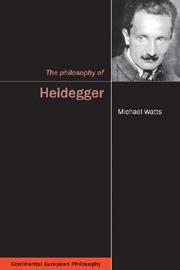Book contents
- Frontmatter
- Contents
- Preface
- Abbreviations
- 1 Heidegger's life
- 2 The meaning of life: the question of Being
- 3 The central ideas in Being and Time
- 4 Conscience, guilt and authenticity
- 5 Being-towards-death
- 6 Dasein's primordial temporality
- 7 The “truth of alētheia” and language
- 8 Heidegger on poetry, poets and Hölderlin
- 9 Heidegger on art
- 10 Heidegger on technology
- 11 Tao, Zen and Heidegger
- 12 Heidegger's politics
- Glossary
- Further reading
- Bibliography
- Index
7 - The “truth of alētheia” and language
- Frontmatter
- Contents
- Preface
- Abbreviations
- 1 Heidegger's life
- 2 The meaning of life: the question of Being
- 3 The central ideas in Being and Time
- 4 Conscience, guilt and authenticity
- 5 Being-towards-death
- 6 Dasein's primordial temporality
- 7 The “truth of alētheia” and language
- 8 Heidegger on poetry, poets and Hölderlin
- 9 Heidegger on art
- 10 Heidegger on technology
- 11 Tao, Zen and Heidegger
- 12 Heidegger's politics
- Glossary
- Further reading
- Bibliography
- Index
Summary
Philosophy is the search for truth. Heidegger claimed that essentially there are two main approaches to truth. The traditional one, which has existed at least since Plato, claims that the truth can be defined in terms of specific criteria for assessing true or false propositions. In contrast, Heidegger investigates the meaning or essence of truth that exists independently of, and prior to, any criteria. “Truth”, in his sense of the word, is no mere presentation of static facts, but the experience of a process of disclosure that is alive and happening in each moment. For Heidegger such “truth” is the essential foundation of all knowledge.
Traditional concepts of truth
In Being and Time, at the beginning of his discussion of truth as “disclosure”, Heidegger comments that in philosophy, the questions of Being and truth have always been associated (BT: 256), but whereas originally their relation was characterized in terms of “disclosure”, this insight was eclipsed by the logical conception of truth, first formulated by Aristotle via his philosophical account that expresses a basic intuition about truth: “to say of what is that it is not, or of what is not that it is, is false, while to say of what is that it is, and of what is not that it is not, is true” (Metaph. Γ 1001b25). The “correspondence theory” (BT: 266–8), which is the traditional and standard conception of truth used today, interprets and expresses Aris totle's basic intuition in terms of a relation of correspondence between mind and world (e.g. between facts and reality).
- Type
- Chapter
- Information
- The Philosophy of Heidegger , pp. 141 - 174Publisher: Acumen PublishingPrint publication year: 2011

